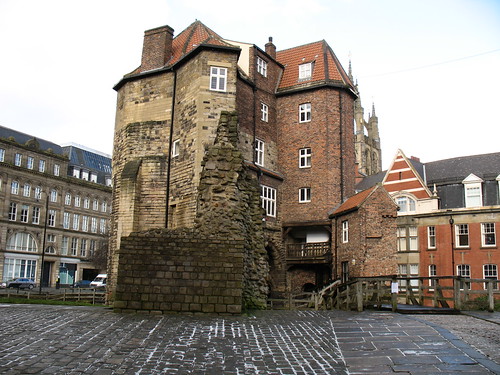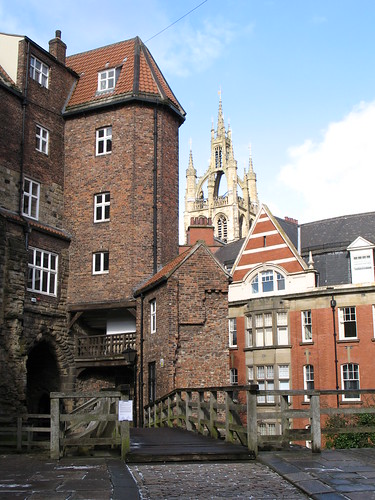Taken from a signboard located in front of the Black Gate:
Built between 1247 and 1250 during the reign of King Henry III, the Black Gate was the last addition to the medieval Castle defences. Now a scheduled Ancient Monument and Grade I Listed Building it was the gatehouse of the barbican, a walled defensive entrance passage leading to the Castle’s North Gate. The gatehouse could be sealed by portcullis (latticed grille or gate made of wood, metal or combination). Mounted in vertical grooves in the walls that are still visible today it could be raised or lowered quickly by means of chains or ropes attached to an internal winch. The narrowness of the barbican passage and its angle to the rest of the Castle wall meant that attackers were restricted in their means of attack, and were left exposed to fire from the Castle’s defenders.
At the front and rear of the original gate were turning bridges. Both have since been replaced with wooden footbridges. These bridges could be closed quickly using counterweights.
Due to its continuous occupancy and alteration from the 17th century right up until the present day very little remains of the medieval layout, except the vaulted chambers on either side of the passage through the Black Gate which are thought to have been guardrooms.
The original height and the original appearance of the roof of the Black Gate remain unknown. The present top two floors, roof and additional arch over the passage were added by Alexander Stephenson in the 17th century.
Stephenson leased the Castle in 1619 including the Black Gate (with the exception of The Keep, Moot Hall and gaoler’s house) from King James I and turned the Black Gate into a house. Upper parts of the Black Gate were extensively remodelled to give the building its present appearance. John Pickell, whose name and the date 1636 appear on a stone high up on the south of the building, used the Black Gate as a tavern.
Popularly thought to describe its appearance, the ‘Black Gate’ derives from Patrick Black, a London merchant who occupied the building in the first half of the 17th century.










Another two excellent photos!

Thanks JD
Well framed Cherie… this section looks like it has been under siege lately….peter:)
Parts of it have seen better days
You mean, you wrote all that down from the gate?
Not exactly… I photographed the sign board whilst I was there and used it as a source of information for my post
I miss the architecture of England-and the bluebells of course.
I will have to see if I can get some new bluebell piccies this year
Pleased you mentioned the name Patrick Black, I was waiting for that ! Good choice of alternative shots of the building.
I am glad you enjoyed them